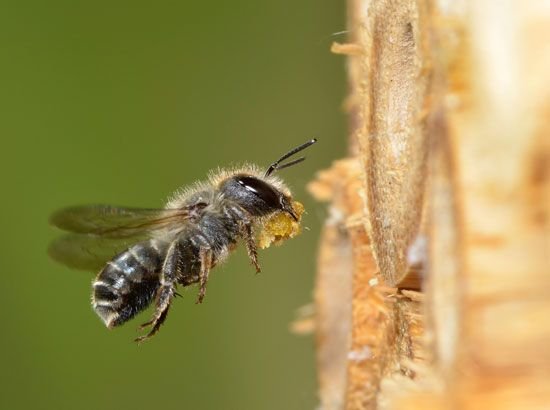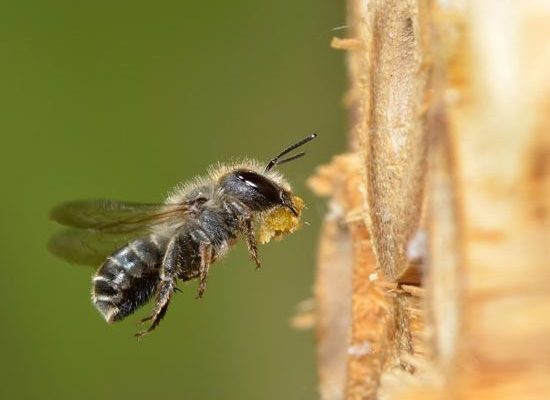
So, what exactly are mason bees? They’re solitary bees that belong to the genus Osmia. Unlike honey bees, which live in large colonies, mason bees prefer to do their own thing. They don’t produce honey, but they excel at pollinating fruits and flowers, often more efficiently than honey bees. Understanding how to identify them can help you appreciate their unique contributions to our environment. Let’s dive into some easy ways to spot these amazing little creatures.
Understanding Mason Bee Characteristics
To identify mason bees, it’s essential to understand their physical characteristics. Generally, these bees are around half the size of a honey bee, measuring about 1/2 inch to 1 inch in length. Their bodies are often covered in fine hairs, giving them a fuzzy appearance, which is a telltale sign of a bee. You might notice they come in various colors, from blue to black or even metallic shades! This color variation is one of the things that makes spotting them so exciting.
Mason bees also have distinct facial features. If you look closely, you might see a small, rounded face with large eyes. These features help them with navigation and foraging. Their legs are uniquely adapted with special hairs that help them collect pollen from flowers. The next time you see a bee buzzing around your garden, check to see if it has those fuzzy legs—it’s a good hint that you might be looking at a mason bee.
Where to Find Mason Bees
Mason bees are quite versatile in their habitat choices, so knowing where to look can significantly increase your chances of identifying them. They typically nest in small cavities, often in wood or hollow stems. Look for old, decaying trees or even in the cracks of wooden fences. If you have an area in your yard abundant with flowering plants, that’s a prime spot for mason bees to visit in search of nectar and pollen.
You might find them in residential gardens, parks, and orchards. They usually emerge when the flowers are in bloom, making early spring a pretty good time to spot them. If you’re planning to attract them to your garden, consider leaving some brush piles or unpainted wood in a sunny spot. This creates a cozy environment for them—and who knows? You could become a mason bee enthusiast in no time!
Identifying Mason Bee Behavior
Paying attention to a bee’s behavior can also give you clues about its identity. Mason bees are quite docile compared to honey bees. They rarely sting, which is great news if you’re a bit wary of bees. When you see a bee hovering around flowers or collecting pollen, it’s likely a mason bee if it acts more like a little worker rather than a defensive guard.
You might notice that mason bees spend a lot of time foraging on a single type of flower before moving on to another. They are particularly attracted to fruit trees, like apple and cherry blossoms. If you see a bee buzzing around your cherry tree and it has that unique fuzzy body, take a moment to admire its diligent work. They don’t waste time; they get busy gathering nectar and pollen, contributing to the cycle of life in your garden.
Differences from Other Bees
It’s easy to confuse mason bees with other types of bees like honey bees or bumblebees. Honey bees are social and live in hives, while bumblebees are larger and have a more robust build. Mason bees, on the other hand, are solitary and much smaller, with a sleek and slender body.
Another noticeable difference is their nesting habits. While honey bees build elaborate hives, mason bees prefer to nest in small cavities. If you see a bee emerging from a tiny hole in wood, take a closer look—it just might be a mason bee! Remember, the more you learn about their behavior and habitats, the easier it will be to distinguish them from other bees buzzing around your garden.
Using Visual Guides for Identification
If you’re still unsure about identifying mason bees, visual guides can be a huge help. There are plenty of online resources, including websites and apps, that provide pictures and descriptions of mason bees. Look for images that show their characteristics, like size, color, and body shape.
A handy tip is to keep a journal of the bees you spot. Take a photo and note the date and location. Over time, you’ll become more familiar with mason bees and their companions. This not only helps with identification but also fosters an appreciation for the biodiversity in your backyard!
Creating a Mason Bee-Friendly Garden
Now that you know how to identify mason bees, why not invite them into your garden? Creating a mason bee-friendly environment can be as simple as planting a variety of flowering plants. Some of their favorites include salvia, lavender, and fruit trees.
Adding nesting sites can also help. Consider setting up bee hotels—these are small wooden boxes with drilled holes where mason bees can lay their eggs. Just remember to place them in a sunny spot, as mason bees love warmth. By making these small changes, you’ll not only support local wildlife, but you’ll also enjoy the benefits of their amazing pollination skills.
Wrap-Up: The Importance of Mason Bees
In conclusion, understanding how to identify mason bees opens a door to appreciating these remarkable pollinators. Their unique features, gentle behavior, and hard work are all vital to our ecosystem. By knowing what to look for—whether it’s their size, color, or nesting habits—you can easily spot them while enjoying your outdoor space.
So next time you’re in your garden, take a moment to observe the buzzing activity around you. With a little curiosity and patience, you’ll soon find yourself recognizing mason bees and celebrating their important role in our world. Happy bee spotting!

